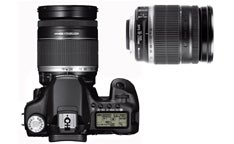Lens Test: Canon 18-200mm f/3.5-5.6 EF-S IS AF
This lens boasts the broadest zoom range of any interchangeable optic from Canon to date.

We may earn revenue from the products available on this page and participate in affiliate programs. Learn more ›

Lens Test: Canon 18-200mm f/3.5-5.6 EF-S IS AF
A 29–320mm equivalent on APS-C Canon EOS models, this lens ($700, street) boasts the broadest zoom range of any interchangeable optic from Canon to date: 11X. A high-end kit option for EOS 50D owners, it probably owes its existence to the phenomenal success of Nikon’s 18–200mm f/3.5–5.6 VR Nikkor. And with the debut of Tamron’s far-reaching and stabilized 18–270mm f/3.5–6.3 lens (tested in this issue), an 11X Canon may be just the beginning. Two glass-molded aspheric elements and two Ultra-low Dispersion (UD) elements control spherical and chromatic aberrations, respectively. And this new lens is internal-focusing, with only four of its 16 elements used to focus. Because these internal elements are significantly smaller than the nonrotating front elements, the lens focuses faster, drains less battery power, and also accepts filter-ringmount accessories.
The Image Stabilizer includes auto panning detection—when you pan during a shot, it turns off the IS along either the horizontal or vertical axis, depending on camera orientation.
HANDS ON: About average in size and weight, the lens sports a large zoom ring that’s ribbed, rubberized, and smooth turning. The relatively small manual focusing collar—ribbed and made of hard plastic—turns with a loose, underdamped, and slightly scratchy feel. Somewhat more rugged than the average kit zoom, it has a metal (not plastic) lens mount, with focusing and stabilizer switches that fall directly under your left thumb as you hold the camera at eye-level.
On our test camera, the Rebel XS, autofocus was fast, moderately quiet, and accurate, and the lens was compact enough to throw no shadow when used with the camera’s built-in flash, except when focused close at the widest zoom settings.
IN THE LAB: On the optical bench, the lens delivered Excellent range SQF performance at the three tested focal lengths, indicating glass of uncompromising sharpness and contrast. At 200mm, its SQF numbers trumped Nikon’s, which topped out only in the Good range, two levels down. (Like the Canon, Sigma’s 18–200mm f/3.5–5.6 OS lens also showed uniformly Excellent resolving power.)
DxO Analyzer 3.0.1 tests of distortion control found Visible-range barrel distortion at 18mm (0.75%), plus Slight pincushioning at 100mm (0.23%) and 200mm (0.20%). The performance, about what we expected, roughly equaled that of the Nikon and was slightly below the Sigma’s.
Light falloff was gone from the corners by f/5 at 18mm, f/6.3 at 100mm, and f/8 at 200mm. Both the Nikon and Sigma lenses fared somewhat better—some focal lengths showed no vignetting whatsoever.
By kit lens standards, the Canon is notable for its close-up powers. At the tight, uniform close-focusing distance of approximately 15.75 inches, magnification ratios ranged from 1:16.9 at 18mm to a gratifying 1:3.16 at 200mm—significantly stronger than the Nikon’s 1:3.9 and almost equal to the Sigma’s 1:3. Tests of the IS system found gains of between 2.5 and 3 stops in sharp shutter speeds for three testers—not quite up to Canon’s 4-stop claim, but par for this course.
CONCLUSIONS: In the past two years, the 11X IS superzoom has become the ideal general-purpose lens—certainly for shooters whose cameras don’t have on-board shake reduction. This Canon fits the mold. Very light and compact, it’s a gracious and adaptable traveling companion. Impressively sharp, it’s also an obvious choice for handheld low-light pictures, including event and theater work. Its real fortes, however, are close-up macro subjects, distant wildlife, and almost everything in between. Sports? Go for it!